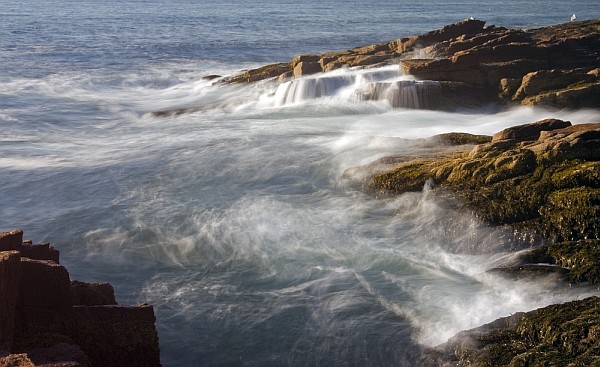
I live in a land-locked place where we can safely disregard the activities of the ocean but if I lived in coastal Maine, and especially if I owned a boat, I’d better know there will be a spring tide tomorrow.
A “spring tide” in the fall?
Yes. A spring tide is the highest high tide and it’s followed by the lowest low. The name has nothing do to with the season but rather that the water is “springing up.”
Tomorrow at Bar Harbor there will be a spring tide of 13.2 feet at 11:40am because of two things the moon is doing today.
Everyone knows the moon affects the tides but we tend to forget that the sun does too. This morning we had a New Moon (all dark) at 7:09am. New Moons occur when the moon is between the earth and sun — all three in a row, an alignment called syzygy(*). With the moon and sun both pulling at the same side of the earth the high tides are that much higher.
Tonight at 9:10pm the moon will be at perigee, its closest approach to the earth. In this position it pulls the ocean more than usual and makes the high tide higher.
Near syzygy and moon perigee are nothing unusual but when they occur at the same time the perigean spring tide is very high. This month the two events are 13 hours apart so the spring tide will be high but moderated.
And for whatever reason, it’s delayed until tomorrow in Frenchman’s Bay.
(photo of waves at Acadia National Park in Maine, from Shutterstock.com.)
(*) See the comments for more information. Astronomers, I look forward to your feedback on these definitions!
Thanks for the heads up Kate! But: new moons occur every month, and aren’t the effect of the moon being between the sun and earth — it’s just the back of the moon facing us. A syzygy is special. 🙂
There are also seasonal variations in tides. This time of the year we think of the sun and moon being about over the equator. Just after the start of winter we have very high high tides at northern latitudes as the moon is further north pulling the water in that direction. It is complex with lots of interactions.
I grew up in Missouri. Our local book of tide tables was very thin.
Perhaps my description wasn’t clear. What I really meant is this:
When the moon is New its bright side faces the sun and we see it’s dark side. During this phase the moon is positioned between the earth and sun though the alignment may not be perfect. http://en.wikipedia.org/wiki/New_moon
When the alignment is really perfect, it’s called syzygy.
However, I found that the term “syzygy” is often used to describe alignments that aren’t perfect, including New moons. http://en.wikipedia.org/wiki/Syzygy_(astronomy)
An imperfect syzygy occurs twice a month: once during the new moon and once during the full moon. During a perfect alignment we see an eclipse.
Astronomers, please help me out here! Mary DeV., what do you say?
Whatever the name of the tide, I can give you the eyeball report. I went surfing this morning in the fog at high tide in Manasquan NJ and it was indeed a high high tide.